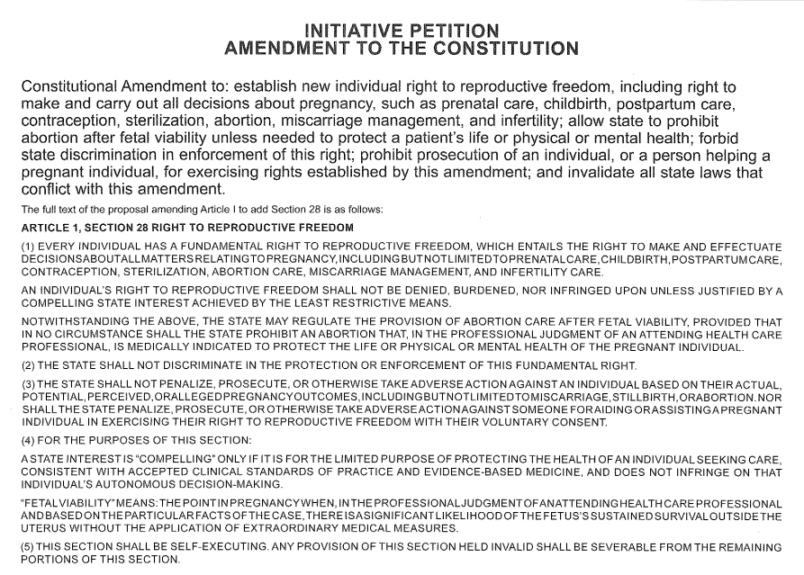The ballot measure to enshrine abortion rights in Michigan’s constitution garnered more petition signatures from everyday voters than any measure in the state’s history: Roughly 750,000, well above the state’s threshold.
But, as of right now, the language won’t be on voters’ ballots this November, and for the strangest reason: GOP officials were upset about the spacing between words in the measure’s proposed language.
Last Wednesday, when Michigan’s Board of State Canvassers met to review the ballot measure, the board’s two Republicans voted against certifying the measure for the ballot, claiming that it had been type-set incorrectly and that words were incomprehensibly smushed together. Now, the issue is pending before the state’s Supreme Court.
“You wouldn’t sign a mortgage that had this kind of mistake in it,” said Chair Tony Daunt, one of the board’s two Republicans, who was nominated by the state GOP’s chairwoman for the seat after Donald Trump’s nearly-successful effort to pressure the same body into rejecting Joe Biden’s presidential win.
Vice Chair Mary Ellen Gurewitz, one of two Democrats on the board, said that in addition to the issue simply not being in the board’s purview, the text was perfectly legible.
“While the words are compressed, I think it’s easy to read. And 700,000 people also thought it was easy to read,” she said, according to Politico. The number of valid signatures supporting the measure’s ballot placement represents more than 9 percent of the state’s voting-age population.
“We simply have no authority to reject this petition based on challenges to the content,” Gurewitz continued. “That is not within our purview.”
An attorney for the pro-choice effort, Steve Liedel, blamed a word space setting in Adobe InDesign for the run-on words, but asserted to Bridge Michigan: “Spaces were not removed.”
Some pro-abortion rights observers have noted that the plain text of the amendment, as viewed on a computer, clearly contains spaces between words, albeit minimal spacing. Others note state law only requires the measure be formatted in eight-point type. The state’s Supreme Court has yet to weigh in on the matter.
See for yourself. Here’s part of the proposed constitutional change that challengers have said is unacceptable:

Michigan’s nearly century-old anti-abortion law, currently tied up in litigation but freshly relevant after the U.S. Supreme Court’s elimination of abortion rights, prohibits the procedure except to “preserve the life” of the mother.
Mark Brewer, an election lawyer and former Michigan Democratic Party chair, dismissed the spacing quibble to WXYZ Detroit.
“They have no authority over the wording or the spacing of the actual proposal. The only thing they have authority over is the form of the petition which they approved months ago,” he said of the canvassing board. “The words are all there. There are no typos. People can read it. It’s a matter of spacing and that’s the function of a printer frankly as to how much spacing is between the words. We actually have constitutional amendments that have typos in them.”
The anti-choice group Citizens to Support MI Women and Children filed the challenge over the amendment’s word spacing in the first place, calling it “incomprehensible” and asserting, “more than three-quarters of a million voters — including the governor and the state attorney general — signed a petition they didn’t read and couldn’t understand.”
But The Reproductive Freedom for All ballot committee, the amendment’s sponsor group, has said the proposal’s language is easily understandable. “More than 730,000 registered voters — a record number — have read, understood, and signed the petition,” a spokesperson told The Detroit News.
Now, the issue is in front of the state’s Supreme Court, which, at least for now, leans Democratic. Another measure that the canvassing board’s Republicans also rejected based on a technical challenge, to expand voting rights in the state, is also before the Supreme Court.
The state’s November ballot is slated to be finalized by Friday, and the state is holding its collective breath to see if a right-wing complaint over some typography issues will prevent one of the most important issues for voters from appearing on the ballot. A spokesperson told WKAR that the justices were reviewing case filings.
No matter what, abortion will be a driving issue on the ballot this November: Tudor Dixon, the DeVos-funded GOP nominee to challenge Gov. Gretchen Whitmer’s (D) reelection bid, said in an interview earlier this year that the incestuous rape of a 14-year-old provided the “perfect example” of a situation in which abortion should be prohibited.
The state’s Supreme Court has not actually said yet whether it is taking up the cases of the two contested ballot measures. But briefs are flowing into the state’s high court.
“Chairman Daunt and Member Houskamp cited the petition’s purportedly ‘missing’ spacing between words—which they believed resulted in typographical errors—as their reasons for denying certification,” a group of county prosecutors said in one such brief. “But Michigan Election Law nowhere mentions required ‘spacing between words’ on a circulated petition. And it certainly does not permit the Board to reject a petition because of insufficient spacing.”
In another filing, Michigan Attorney General Dana Nessel compared the spacing in the abortion amendment to another notable legal document: The U.S. Constitution.



